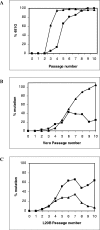Rational design of genetically stable, live-attenuated poliovirus vaccines of all three serotypes: relevance to poliomyelitis eradication
- PMID: 16912313
- PMCID: PMC1563845
- DOI: 10.1128/JVI.00370-06
Rational design of genetically stable, live-attenuated poliovirus vaccines of all three serotypes: relevance to poliomyelitis eradication
Abstract
The global eradication of poliomyelitis caused by wild-type virus is likely to be completed within the next few years, despite immense logistic and political difficulties, and may ultimately be followed by the cessation of vaccination. However, the existing live-attenuated vaccines have the potential to revert to virulence, causing occasional disease, and viruses can be shed by immunocompromised individuals for prolonged periods of time. Moreover, several outbreaks of poliomyelitis have been shown to be caused by viruses derived from the Sabin vaccine strains. The appearance of such strains depends on the prevailing circumstances but poses a severe obstacle to strategies for stopping vaccination. Vaccine strains that are incapable of reversion at a measurable rate would provide a possible solution. Here, we describe the constructions of strains of type 3 poliovirus that are stabilized by the introduction of four mutations in the 5' noncoding region compared to the present vaccine. The strains are genetically and phenotypically stable under conditions where the present vaccine loses the attenuating mutation in the 5' noncoding region completely. Type 1 and type 2 strains in which the entire 5' noncoding regions of Sabin 1 and Sabin 2 were replaced exactly with that of one of the type 3 strains were also constructed. The genetic stability of 5' noncoding regions of these viruses matched that of the type 3 strains, but significant phenotypic reversion occurred, illustrating the potential limitations of a rational approach to the genetic stabilization of live RNA virus vaccines.
Figures





Similar articles
-
Live-attenuated strains of improved genetic stability.Dev Biol (Basel). 2001;105:179-87. Dev Biol (Basel). 2001. PMID: 11763326 Review.
-
The vaccine origin of the 1968 epidemic of type 3 poliomyelitis in Poland.Virology. 2000 Dec 5;278(1):42-9. doi: 10.1006/viro.2000.0614. Virology. 2000. PMID: 11112479
-
Vaccine-derived poliovirus (VDPV): Impact on poliomyelitis eradication.Vaccine. 2009 May 5;27(20):2649-52. doi: 10.1016/j.vaccine.2009.02.071. Epub 2009 Mar 3. Vaccine. 2009. PMID: 19428874 Review.
-
Mutations in Sabin 2 strain of poliovirus and stability of attenuation phenotype.Virology. 1999 May 25;258(1):152-60. doi: 10.1006/viro.1999.9718. Virology. 1999. PMID: 10329577
-
Risks associated with the use of live-attenuated vaccine poliovirus strains and the strategies for control and eradication of paralytic poliomyelitis.Expert Rev Vaccines. 2012 May;11(5):609-28. doi: 10.1586/erv.12.28. Expert Rev Vaccines. 2012. PMID: 22827246 Review.
Cited by
-
Multiple independent emergences of type 2 vaccine-derived polioviruses during a large outbreak in northern Nigeria.J Virol. 2013 May;87(9):4907-22. doi: 10.1128/JVI.02954-12. Epub 2013 Feb 13. J Virol. 2013. PMID: 23408630 Free PMC article.
-
SAT2 Foot-and-Mouth Disease Virus Structurally Modified for Increased Thermostability.J Virol. 2017 Apr 28;91(10):e02312-16. doi: 10.1128/JVI.02312-16. Print 2017 May 15. J Virol. 2017. PMID: 28298597 Free PMC article.
-
Advances and challenges in poliomyelitis vaccines: a comprehensive review of development, production, and global deployment.Front Public Health. 2025 Jul 16;13:1611028. doi: 10.3389/fpubh.2025.1611028. eCollection 2025. Front Public Health. 2025. PMID: 40740383 Free PMC article. Review.
-
Development of a Quantitative One-Step RT-PCR Method for the Detection of Sabin 2 Virus Contamination in a Novel Oral Poliovirus Vaccine Type 2.Vaccines (Basel). 2021 Jun 23;9(7):688. doi: 10.3390/vaccines9070688. Vaccines (Basel). 2021. PMID: 34201447 Free PMC article.
-
Engineering the Live-Attenuated Polio Vaccine to Prevent Reversion to Virulence.Cell Host Microbe. 2020 May 13;27(5):736-751.e8. doi: 10.1016/j.chom.2020.04.003. Epub 2020 Apr 23. Cell Host Microbe. 2020. PMID: 32330425 Free PMC article. Clinical Trial.
References
-
- Bellmunt, A., G. May, R. Zell, P. Pring-Akerblom, W. Verhagen, and A. Heim. 1999. Evolution of poliovirus type I during 5.5 years of prolonged enteral replication in an immunodeficient patient. Virology 265:178-184. - PubMed
-
- Contreras, G., K. Dimock, J. Furesz, C. Gardell, D. Hazlett, K. Karpinski, G. McCorkle, and L. Wu. 1992. Genetic characterization of Sabin types 1 and 3 polio vaccine virus following serial passage in the human intestinal tract. Biologicals 20:15-26. - PubMed
MeSH terms
Substances
LinkOut - more resources
Full Text Sources
Other Literature Sources
Medical

